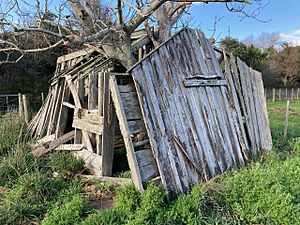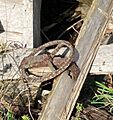Carkeek Observatory facts for kids
Quick facts for kids Carkeek Observatory |
|
|---|---|
 |
|
| Location | Murphys Line, Featherston, Wairarapa, New Zealand |
| Built | circa 1867 |
| Built for | Stephen Carkeek |
| Architect | Stephen Carkeek |
| Owner | South Wairarapa District Council |
The Carkeek Observatory is the oldest observatory still standing in New Zealand. It was built around 1867. A man named Stephen Carkeek built it on his farm. He was a retired government worker who loved looking at stars.
The building was made of wood and had two parts. One part was an eight-sided room with a spinning canvas roof. The other part was a rectangular room next to it. Stephen Carkeek died in 1878. After that, the observatory stopped being used for stars. It became a shed for farm tools.
Even in the 1980s, it was still mostly complete. But now, it's mostly fallen apart. You can still see the rectangular part and some of the spinning roof's parts. On June 26, 2020, it was added to the New Zealand Heritage List. It is now a very important historic place.
Contents
Meet Stephen Carkeek, the Star-Gazer
Stephen James Carkeek (1815–1878) was born in a place called Swansea. He moved to New Zealand with his family in 1841. He started working for the Customs Service. This job involved collecting taxes on goods coming into the country.
In 1849, he moved to Wellington. There, he became the main Collector of Customs. Later, he became the first Inspector for all of New Zealand's customs.
Stephen Carkeek had worked on ships when he was younger. This made him interested in how sailors kept time and studied the stars. He continued this hobby in Wellington. He even helped the government build an observatory there. This observatory had a time ball on its roof. A time ball would drop at a certain time each day. This helped ships set their clocks correctly.
In 1866, Carkeek retired at age 51. He moved to the Wairarapa area to start sheep farming. His farm, called Torohanga, was near Featherston. He built his own private observatory there. He was well-known for his love of astronomy.
The Observatory Building
The Carkeek Observatory was built around 1867. It was not very big. It was made mostly from local tōtara wood planks. These planks were put together with handmade iron nails.
The observatory had two main parts:
- An eight-sided room that was about 4.57 meters (15 feet) wide. This room had a dome on top.
- A rectangular room next to it, about 4.24 by 3.45 meters (14 by 11 feet). This part was called the transit annex.
The entrance door was in the annex. Steps led up to the dome room floor. This floor was about 84 centimeters (33 inches) higher than the ground. The "dome" on the observation room was probably cone-shaped. It was made of canvas over a wooden frame. It sat on iron rollers. This allowed it to spin around. Spinning helped it follow the movement of the stars as the Earth turned.
A Common Design for Star-Gazers
This type of observatory design was very popular for amateur astronomers. It is often called a "Romsey-style" observatory. This name comes from a ready-made observatory invented in 1871. It was sold by Reverend Edward Lyon Berthon.
Both designs were small and cheap. They were made of wood and had a spinning dome. They were based on the famous Bedford Observatory. Admiral William Henry Smyth designed that observatory. His plans were published in his book A Cycle of Celestial Objects in 1844. Stephen Carkeek might have owned this book.
What Carkeek Observed
Carkeek likely had two telescopes in his observatory. One was a 4-inch refractor in the dome room. The other was a transit telescope in the annex. This transit telescope was probably 4.5–6.4 cm (1.8–2.5 inches).
He would have used the transit telescope to find the exact latitude and longitude of his observatory. He also used it to set his chronometer (a very accurate clock). He did this by watching certain "clock stars." He might have also had an astronomical clock.
With his refractor telescope, he could have watched eclipses. He could also observe lunar occultations, which is when the Moon passes in front of a star. He might have watched planets and comets. He could also track double stars and look for new variable stars. These were all common activities for amateur astronomers back then. Sadly, none of his notes or records have survived. He also didn't publish any of his observations.
From Use to Ruin
Stephen Carkeek died suddenly in 1878. His belongings and farm animals were sold off. But the sale notice did not mention any telescopes or astronomy books. No one knows what happened to his papers or observation records.
The observatory building stayed on the farm. The farm was sold to William Hodder. His family farmed the land for five generations. The observatory was turned into a storage shed for farm tools. The dome and two walls were taken down but kept nearby. Graham Hodder, a family member, remembers exploring it as a child. He said they were told not to damage it. This might be why parts of it are still there today.
Rediscovery of the Observatory
For over 100 years, the observatory was mostly forgotten. Then, in 1987, an amateur astronomer from Wellington, Sydney Cretney, heard about it. He visited the site with other astronomers. Cretney and another astronomer, Tony Dodson, wrote articles about the observatory. In 1994, the Wellington Astronomical Society organized a trip for people to see it.
In 1987, the observatory was in pretty good shape. But by 1994, it was already starting to fall apart. The roof and two walls of the dome room were gone. But the parts that made the dome spin were still there. The rectangular annex was mostly standing. A large walnut tree had grown through it and out one of its observation windows. By 2014, the dome room had mostly collapsed. The iron base ring had broken, and the wheels had fallen off.
Protecting a Piece of History
The Carkeek Observatory is important for the history of astronomy in New Zealand. The first major professional observatory, Mt John, was not built until the 1960s. Before that, people like Carkeek, who loved stars as a hobby, did most of the astronomy.
The land where the observatory stands was bought in 2014. The South Wairarapa District Council bought it. They plan to use the land for treated wastewater.
In March 2020, the Wairarapa Dark Sky Association asked for the observatory to be protected. They wanted it to be a Category I historic place. This means it is "outstandingly important historically." The South Wairarapa District Council supported this idea.
Protecting the observatory will become part of the local plan for the area. It is also part of a bigger plan for a Dark Sky Reserve. This reserve aims to protect the night sky from light pollution. The plan is to make the observatory stable and protect it. They might even build a copy of it nearby. The Dark Sky Association has also suggested that an architect draw plans. This would let local people build their own backyard observatories like Carkeek's.
Heritage New Zealand officially added the observatory to the Heritage List. It became a Category I historic place on June 26, 2020.
Images for kids








